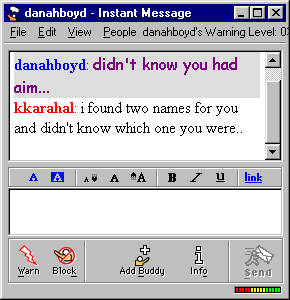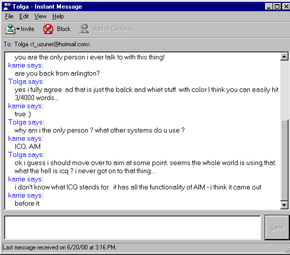|
Instant Messaging (Zephyr, ICQ, AIM, Talk)
Zephyr, ICQ
Space Zephyr and ICQ are similar in that they are instant messaging systems. They have many similarities and a few minor differences. Of the two, Zephyr was the first to come along. For people to communicate using Zephyr, they each need to have it running on their machine and they need to know the remote users username. They can then send windowgrams to each other (see top image in Figure below). This allows for nearly instantaneous one on one communication. What made this system even more interesting was the ability of the users to hide themselves while logged on or to set different levels of access to themselves. Zephyr also allowed for the users to create a .anyone file, a file to list usernames of people for the purpose of knowing when and if they are logged in. This was followed by the ability to send one message to a class or group of people in that class. Some of the limitations of Zephyr were that it only ran on Unix machines with kerberos enabled in select schools. There is now a windows version with some of the same security constraints. ICQ is a newer system that has taken the instantaneous message approach a litter further. One of the first breakthroughs of ICQ was that it ran on many platforms and was location independent. That is, you did not have be within a university and you could run in on a Mac, a Windows machine, a Unix box, etc. It also provided for instant messaging within a web browser, so if one was away from their primary machine that had the software installed, they could still communicate. Making the interface easy to learn to use and allowing for the freedom of being anywhere made it one of the widely used messaging systems today. ICQ has much of the functionality of Zephyr. In this case, one sends a message to friend using their nickname or ID number. However, it also allows for more contact. That is, there is directory of users that allow their name to be listed. Using this, one can contact an old friend or begin to converse with a stranger. ICQ also has more access constraints. One can allow anyone to contact them or only those that have authorization. Also, one can ignore individual people, can can hide. They can display levels of interest in conversing, and can switch from instantaneous messaging to talk with the click of a button. Similarly to Zephyr, the user can have a contact list of people they frequently speak to. This system has taken on other uses as well. Oftentimes people have ICQ constantly running in the background. This gives those who have you on their contact list the notion of whether or not you are present online at that time. It also allows for people to share images and converse using audio. With all of these systems, the space is disjoint. That is the users each see different things and the messages are brought to their local location. Shared social spaces are visualized throught the contact lists and the access levels that create groups of people for conversation.
Time synchronous (must type return before message is sent)
AIM, MSN, Talk
Space These three systems are also messaging systems similar in many ways to Zephyr and ICQ. Where the big difference arises is in how people view the conversation. In Zephyr and ICQ, the local user sees only the messages sent by the remote users. With AIM, MSN, and talk, the users see essentially the same thing (with talk, it is inverted - the local user is always the top half of the screen). These systems bring the local and the remote into the same space so that the users see the same conversation. AIM is currently available for many platforms and MSN is currently available for windows machines (and requires one to user their passport service). Both have many of the functionalities of Zephyr and ICQ in terms of access restrictions. They both have contact lists and can see who is running the messaging software. They can block certain users. AIM allows the local user to issue warnings to remote users if they are spamming them or sending unwanted messages; given enough warnings a user is removed from the system. The change is in the interface of how the messages from both users is presented. The username of the person is followed by their message, and the visual is sequencial. Both users see what they wrote as well as what was written to them. With AIM, the user can also save a transcript of a conversation for later perusal. This allows for a persistent to a conversation which is more commonaly associated with asynchronous messaging systems such as usenet. Initializing a conversation with talk is different than with the other mentioned messaging systems. With the others, one can observe who is around. That is, who exists in the available space for communication. With talk, one initiates a conversation by typing username@machine-name.domain-name. One must find out beforehand if they are logged on and must know information such as username and machine name from other sources. Another addition made by AIM is the ability to allow more than two people to participate in a conversation. This alters the space from that of a two-person conversation to that of a shared space among multiple users that begins to resemble traditional chat interfaces.
Time AIM and ICQ are instantaneous messaging systems. As soon as the user presses the 'enter' or return' key, the message is sent. This is similar to Zephyr and ICQ. The talk interface appears similar, but is many subtle features. The first is that not only is it synchronous, but it is near-real-time typing. That is, the remote user can observe as you type each character of a word. This allows for conversation behaviors that are more common to those we are familiar with in speach. For example, a conversation in email or AIM is made up of discrete sequencial messages. A user finishes a complete thought and sends the message. With talk, one user can interrupt another user. They can also change the stream of the conversation as they synchronously read what the other user is writing. This is, in a sense, performing sentence or thought repair if they feel they have either not typed the correct thing or if it did not convey what they wished it to. It allows for finer grade nuances to transmit as well as the words of the conversation.
  Figure X. Snapshot from AIM (above). Snapshot from MSN (below).
|
